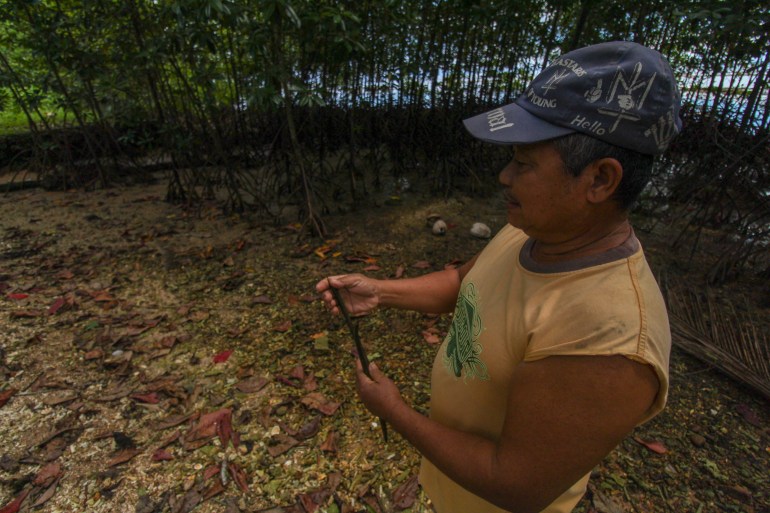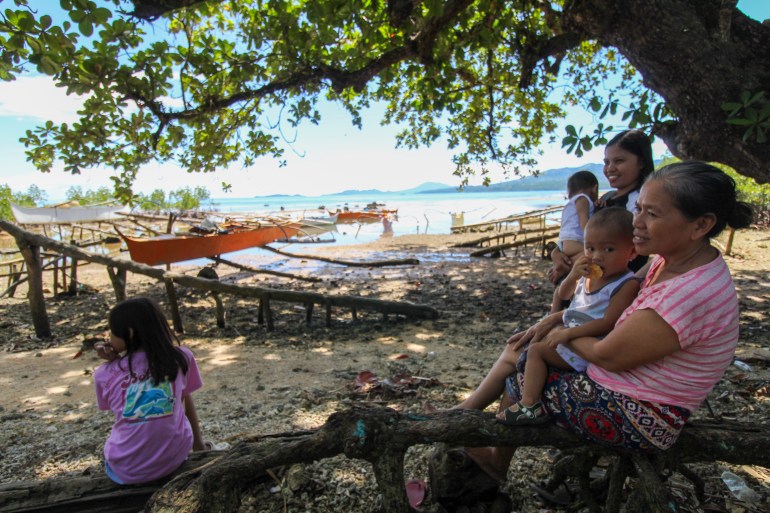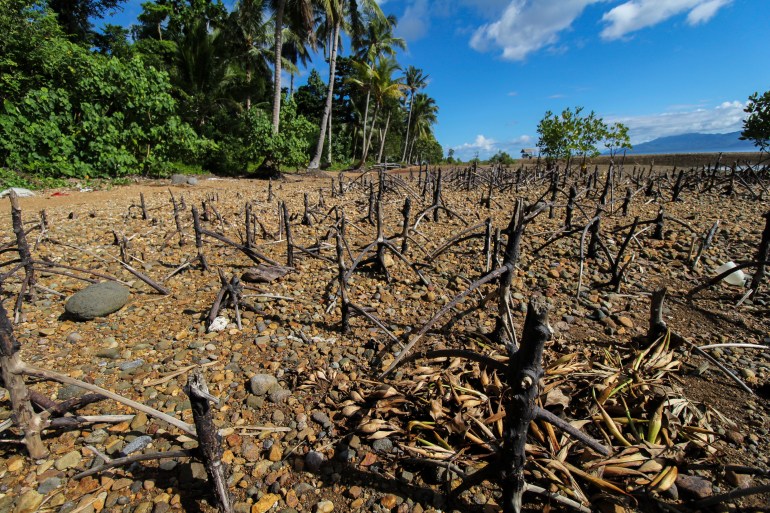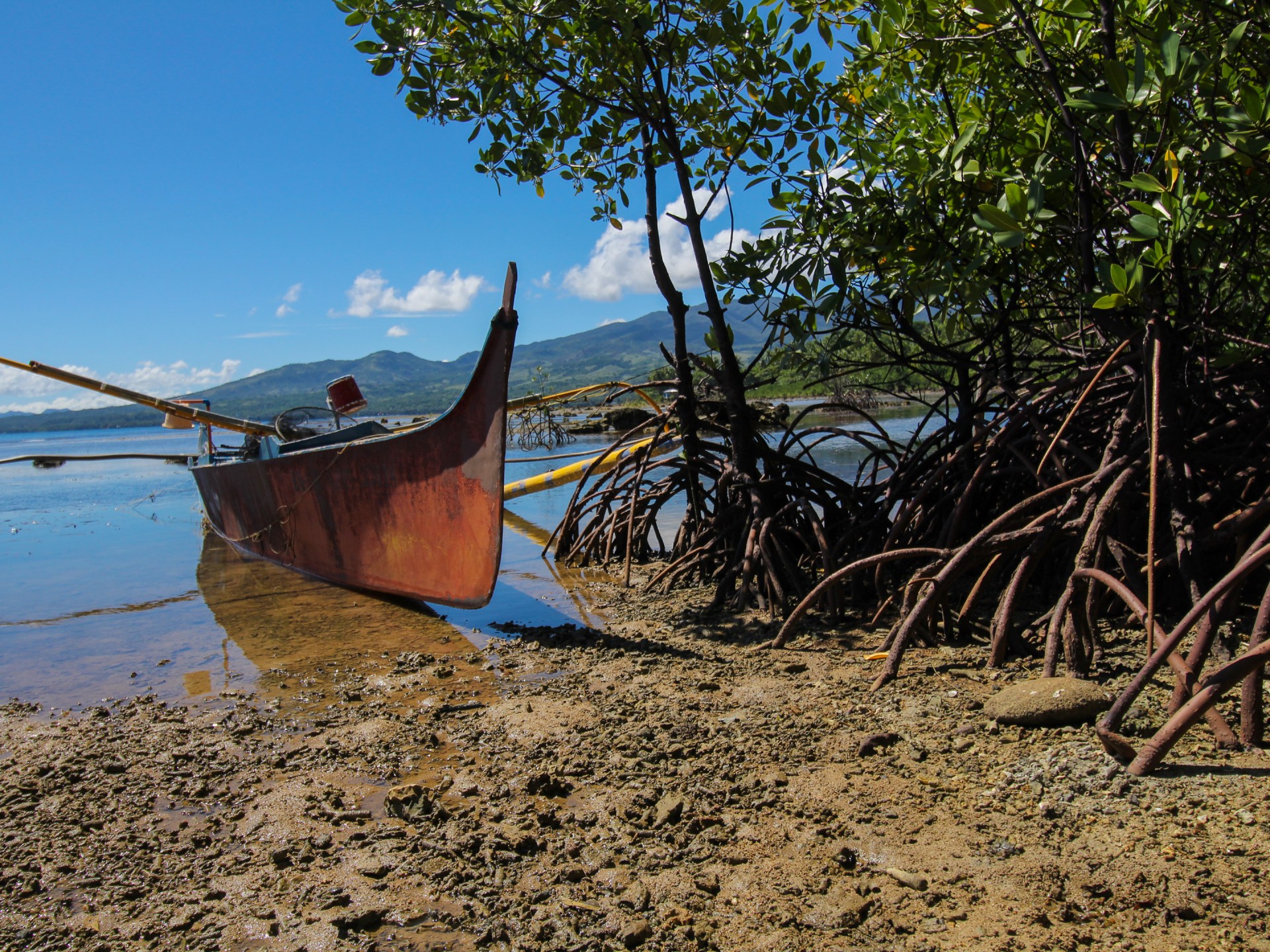10 years after Haiyan, are mangroves protecting Philippine coastal areas? | Climate Crisis News
Tacloban, The Philippines – Twice a month for the last 10 years, pig farmer Alejandro Sumayang has planted mangrove plants along the shoreline a few metres from his home.
Pushing a stick into the muddy ground, he creates a hole for the seedling, tying it to a piece of bamboo to prevent the tide from washing it away.
“This is what shields me,” he said, crouching to inspect a recently planted row of plants.
The back of Sumayang’s makeshift house faces the Pacific Ocean in the Philippines’s central Leyte province. Ten years ago, on November 8, 2013, tsunami-like waves whipped up by Super Typhoon Haiyan crashed into his home in Silago, leaving only broken wooden beams standing amid the wreckage.
Haiyan was one of the strongest typhoons ever to make landfall. More than 6,300 people were killed as the storm swept across the island of Leyte, flattening homes and causing a storm surge that swamped entire neighbourhoods. The government said at least 13 million people were affected.
Leyte was struck again by a typhoon in December 2021. Typhoon Rai rivalled Haiyan’s intensity.
“I’d have lost my house again if we hadn’t planted anything. From afar we could see the waves losing their momentum, breaking apart before they reached the shore,” Sumayang told Al Jazeera.

About 20 typhoons a year enter Philippine territory. For the last 12 years, the Southeast Asian archipelago has kept the top spot for the most vulnerable and at-risk country for natural disasters in the World Risk Index produced by Germany’s Ruhr University Bochum.
In Haiyan’s wake, several coastal communities began mangrove reforestation efforts, arguing nature was the most effective way to deal with the effects of climate change.
Four villages in Silago were among the first to start, working with NGOs and village officials to begin planting a year after the disaster. The characteristic bulbous roots and flat leaves of the varying types of mangrove now line 215sq km (83 sq miles) of the town’s coastal area.
The Leyte Center for Development (LCDE), a humanitarian organisation which supported the planting in Silago, believes the plants helped save 2,000 coastal residents from Rai’s onslaught.
“It is a testament to the effectiveness of an eco-systems-based approach and it cost the people practically nothing,” said the LCDE’s director Minet Aguisanda-Jerusalem.
Infrastructure ‘obsession’
There has been little support from any officials at the municipal level or above, however.
The government has instead backed man-made interventions including a vast concrete sea wall in Tacloban City, Leyte’s capital.
Construction on the 16.9 billion Philippine peso ($304.5m) Storm Surge Protection Project (SSPP) began in 2016.
The 44.48km (27.6 miles) long concrete seawall was supposed to have been finished by 2020 but only 58 percent of the work has been done.

Delays have been caused by “Right-Of-Way Acquisitions, fluctuating prices of materials [and] request of additional features in the tide embankment”, the Department of Public Works and Highways (DPWH) regional office told Al Jazeera in an email.
Along some sections of the SSPP, the wall has already started to crack and crumble, exposing the steel rebars inside to the elements.
But the DPWH is standing by the project. In a report it shared with Al Jazeera, it advised engineering offices on the island “to adopt the SSPP standards in protecting their shores all over the region”.
Professor William Holden, an environmental geographer from the University of Calgary who is studying the situation in Tacloban, says that even when the wall is finished, it will probably not be enough to protect the city.
“Climate change means warmer air holding more water and thus heavier rainfall events. So there’s no way engineers can predict how big of a seawall to build. Future typhoons will eventually dwarf Haiyan,” said Holden, who suspects the maintenance of the SSPP will also prove costly.
Jon Bonifacio, the national coordinator for the environmental advocacy group Kalikasan, worries the wall could even exacerbate the effects of climate change, because it risks trapping any water that enters the city during a storm and causing prolonged flooding.
He is also critical of the social cost of the project, which required thousands of coastal residents to leave their homes, separating them from their livelihoods. He faults the administration of President Ferdinand Marcos Jr for continuing the state’s “obsession with grey infrastructure” as it “ends up displacing impacts rather than eliminating climate change impacts”.
Natural breakwater system
The Philippines is home to 46 of the world’s 70 species of mangrove trees and shrubs, which thrive in the tidal saltwater shallows where the land meets the sea.
While research has shown the plants help reduce coastal communities’ vulnerability to tsunamis and storm surges, they are also under threat.
The Philippines is estimated to have lost about 49 percent of its mangrove forests since 1920.

Professor Eduardo Mangaoang, the founder of the Regional Climate Change R&D Center at Visayas State University in Leyte, urged authorities to heed the beneficial science behind mangroves.
“The stems and bodies are a natural breakwater system against strong waves. It stabilises and holds shoreline soil together and is a nursery for fish,” Mangaoang explained to Al Jazeera.
In 2014, Jecel Espina-Pedel, a 14-year-old from Silago and a self-described “nature lover”, joined the hundreds of others in a coordinated mangrove planting effort.
Gazing out of her window, she remembers seeing the first leaves sprout in just six months. Within a few years, the surrounding soil was totally transformed.
“The ground went from rocky to muddy. We could see small holes which were new habitats. We looked under rocks and saw fish we’d never seen here before,” she explained, still thrilled by what happened.
Pedel comes from a family of fisherfolk. Before long, they were often eating shellfish for dinner and selling the rest of their catch by the roadside.
“It has multiple co-benefits: food sources, science-based, and it creates a carbon sink. It’s internationally recognised. But locally, there isn’t a comprehensive plan for this,” Gerry Arances, the director of the Center for Energy, Ecology and Development in Manila, told Al Jazeera.
For mangroves to survive, the correct varieties of seedlings must be chosen and placed properly along the shore.
In 2015, the Department of Environment and Natural Resources (DENR) drew flak for using improper methods in a 1 billion Philippine peso ($18m) mangrove reforestation project. In 2023, advocates again criticised the department for repeating the mistake in Bohol and Negros Occidental.
Mangaoang attributes the success in areas like Silago to the attention of local residents who continue planting while keeping the mangroves free of barnacles and other parasites.

The academic travels all over the region promoting mangroves. In his town of Baybay, Leyte, he finally convinced Mayor Jose Carlos Cari to support a community mangrove plan for next year, a first for the region.
Overall, Mangaoang says, community-coordinated mangrove planting is “still at the early stages. Coastal communities have a lot of local practices that need support. They themselves are scientists, they just don’t know it.”
‘We are protected’
The government, however, continues to expand its engineering interventions in Leyte.
In February of this year, construction began on the Tacloban City Causeway. According to the DPWH, the 4.5 billion Philippine peso ($81.1m) 2.5km (1.5 miles) road will reduce city travel time and “protect the life and property of the residents/constituents in the area from erosive tidal actions”.
The road embankment will be built on reclaimed land.
That entails bulldozing the mangroves along Cancabato Bay, classified as a protected area by the city for its biodiversity. The bay is a popular fishing ground and its mangrove density was increased by the local fishing community after Haiyan.
“There needs to be proper planning around these issues,” said Ian Fry, the United Nations special rapporteur on the protection of human rights in the context of climate change, after visiting Tacloban during the 10th-year commemoration of Haiyan. He called the potential loss of mangroves a “serious concern”.
Roque Regis, a bay area community leader, estimates their own efforts have added an extra 30 percent to the bay’s mangroves since Haiyan. He called the government “deaf” for ignoring its own protections over the bay and residents’ pleas to halt construction.
After the typhoon, “they displaced everyone living near the coast”, Regis told Al Jazeera. “Now they’re set to do the same in Cancabato Bay. They want to ‘clean up’ the area for tourists. But they’re taking down our homes and our fishing grounds.”
With the Philippine government’s response to climate disaster unfinished, affected communities remain convinced that the solution to future problems remains with nature.
They plan to persist in their defence of the trees that they believe both save and nurture them.
“There were doubters when we started planting, saying the mangroves would be home to snakes, or that they wouldn’t work. But look at us here, we are protected. This is a gift to the people,” said Sumayang.




